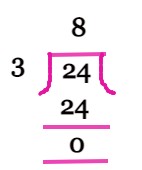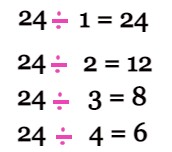The concept of factors in mathematics refers to the divisors of a given number that can divide it evenly without leaving any remainder. To determine the factors of a number, we can employ different approaches like the division method and the multiplication method. Factors find practical relevance in real-life situations, such as dividing objects into equal rows and columns, comparing prices, and conducting currency exchanges. This article aims to explore the intricacies of factors and provide guidance on how to identify the factors of a given number.
What is Factor?
A factor is a numerical value that can divide another number evenly, with no remainder. Essentially, when we multiply two whole numbers to obtain a product, those numbers are considered factors of the product because they are divisible by it.
There are two primary methods for determining factors: multiplication and division. Additionally, rules of divisibility can also be employed to find factors.
For example, let’s consider the number 12. The factors of 12 are 1, 2, 3, 4, 6, and 12. This is because each of these numbers can divide 12 without any remainder.
Key Points
Here are a few key points about factors:
- Factors are always whole numbers or integers.
- Every number is a factor of itself, as well as 1.
- Factors are always smaller than or equal to the original number.
- If a number has only two factors (1 and itself), it is called a prime number.
- If a number has more than two factors, it is called a composite number.
Prime Factorization
Prime factorization is the process of expressing a composite number as a product of its prime factors. It involves breaking down a number into its constituent prime numbers. Here’s how prime factorization works:
- Start with the given composite number.
- Begin by dividing the number by the smallest prime number, which is 2. Repeat the division until the number is no longer divisible by 2.
- Move on to the next prime number, which is 3, and continue the division process until the number is no longer divisible by 3.
- Repeat this process with subsequent prime numbers (5, 7, 11, and so on) until the number is completely factored.
- The prime factors obtained through this process, when multiplied together, yield the original composite number.
Let’s illustrate this with an example:
Consider the number 72.
- We start by dividing 72 by the smallest prime number, which is 2. 72 ÷ 2 = 36.
- We continue dividing 36 by 2: 36 ÷ 2 = 18.
- Next, we divide 18 by 2: 18 ÷ 2 = 9.
- Now, we try the next prime number, which is 3. We divide 9 by 3: 9 ÷ 3 = 3.
- Finally, we have 3, which is already a prime number.
- We have obtained the prime factors: 2, 2, 2, 3, and 3.
- Multiplying these prime factors together gives us the original number: 2 * 2 * 2 * 3 * 3 = 72.
Therefore, the prime factorization of 72 is 2^3 * 3^2.
Is 3 a factor of 24?
Solution: We divide 24 by 3.
As we see there is no remainder or we can say that remainder is 0.
So 3 is a factor of 24.
Properties of Factors
1. 1 is a factor of every number. Or every number is divided by 1.
For example

2. Every number is a factor of itself.
For example

3. If a number is factor of another number than all its factors will be the factors of that number.
Suppose, 6 is a factor of 12.
And 2 and 3 are the factors of 6.
So, 2 and 3 will be the factors of 12.
4. A factor can not be larger than its products.
5. 0 can not be factor of any number.
6. Every number has a minimum of two factors 1 and the number itself.
How to Find Factors of a Number
There are two way of finding the factors of a number, which is given below:
1. Factor by multiplication Method
Suppose, we have to find the factors of 24.
So,
1 x 24 = 24
2 x 12 = 24
3 x 8 = 24
4 x 6 = 24
So, the factors of 24 are 1,2 3, 4, 6, 8, 12 and 24.
2. Factor by Division Method
We may try to find the factors of 24 by the division method.
As,

So, the factors of 24 are 1,2 3, 4, 6, 8, 12, and 24.
Examples of Factors
- factors of 16
- factors of 18,
- factors of 30,
- factors of 48,
- factors of 72,
- factors of 60,
Here are the examples of factors:
Factors of 16: 1, 2, 4, 8, 16
Factors of 18: 1, 2, 3, 6, 9, 18
Factors of 30: 1, 2, 3, 5, 6, 10, 15, 30
Factors of 48: 1, 2, 3, 4, 6, 8, 12, 16, 24, 48
Factors of 72: 1, 2, 3, 4, 6, 8, 9, 12, 18, 24, 36, 72
Factors of 60: 1, 2, 3, 4, 5, 6, 10, 12, 15, 20, 30, 60
Frequently Asked Questions of Factorization
What is factorization?
Factorization is the process of breaking down a number or expression into its constituent factors. It involves finding the numbers or expressions that, when multiplied together, yield the original number or expression.
What is prime factorization?
Prime factorization is a specific type of factorization where a composite number is expressed as a product of its prime factors. Prime factors are the smallest prime numbers that divide the given number without leaving a remainder.
Why is prime factorization important?
Prime factorization helps in simplifying fractions, finding the greatest common divisor (GCD) or highest common factor (HCF), identifying the factors of a number, solving equations, and understanding the mathematical properties of numbers.
How can I find the prime factors of a number?
To find the prime factors of a number, you can use the method of repeated division by prime numbers. Start dividing the number by the smallest prime number and continue dividing by prime numbers until you can no longer divide evenly. The resulting prime numbers are the prime factors.
Can every number be factorized?
Yes, every positive integer greater than 1 can be factorized. Some numbers may have prime factors that are repeated.
What is the difference between factorization and prime factorization?
Factorization refers to the process of breaking down a number or expression into its constituent factors, which can be either prime or composite. Prime factorization specifically focuses on expressing a composite number as a product of its prime factors.
Are there any special methods or algorithms for factorization?
Yes, various algorithms exist for factorization, such as trial division, Pollard’s rho algorithm, quadratic sieve, and the general number field sieve (GNFS). These algorithms are used for factorizing large numbers and play a crucial role in cryptography and number theory.
Is factorization only applicable to whole numbers?
Factorization is commonly associated with whole numbers, but it can also be applied to algebraic expressions, polynomials, and other mathematical entities.
